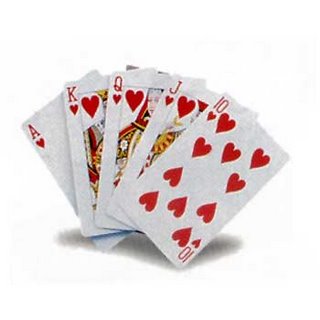Cards Facing Up
 You have a deck of 52 cards, all facing down. Blindfolded, you turn over seven of the cards in the deck so that they face up, then you shuffle the entire deck. Remaining blindfolded, you now need to separate the cards into two piles so that each pile contains the same number of face-up cards.
You have a deck of 52 cards, all facing down. Blindfolded, you turn over seven of the cards in the deck so that they face up, then you shuffle the entire deck. Remaining blindfolded, you now need to separate the cards into two piles so that each pile contains the same number of face-up cards.Contributed by Steve Kass and printed in SQL Server Magazine, March, 2006.


7 Comments:
Hint: The number of cards in each pile doesn't need to be the same - just the number of cards facing up.
so, you shuffled the 7 cards that were face-up in with the other cards that were face down? One shuffle? Two? these things matter when I figure out the statistical probability of a face-up card being on the top, two in a row, in the middle...and so forth. anyway, 7 is an odd number so how could you ever have the same number in both decks unless you got rid of a card somewhere? Or unless you mean that there is "one" in one pile and "at least one" in the other pile. If that is what you mean, I know how to do it. Otherwise, clarify this dumb puzzle!
Yes, you shuffled them together. Once, twice, it doesn't matter. There will be the same number in each pile when you do this correctly. And I do not mean one in one pile and at least one in the other. I mean the same number in each pile. If you do it correctly, the fact that seven is an odd number will be irrelevant, and you do not need to "lose" a card.
still thinking on this one....am I turning a card sideways? You know I am a true blonde and so this isn't really making sense to me yet. don't give the solution though...yet!
No, you don't have to turn anything sideways. You have two "sets" and you want them to be the same. It's a math problem.
oh yeah, I figured this one out and told you the answer on the phone. I am glad I could show you how awesome I am!
So, here's the answer, if you're ready:
After you've shuffled the 7 face-up cards back into the deck, take the first 7 cards off the top to make your second pile. At this point there is some unknown number of face-up cards in the stack of 7 that you just drew off, we'll call that n. So in your stack of 45 remaining cards there is 7-n face-up cards.
Since your second pile has 7 total cards in it and n face-up cards, if you turn that entire pile over, it will have 7-n face-up cards, and then both piles have the same number of face-up cards: 7-n
Post a Comment
<< Home